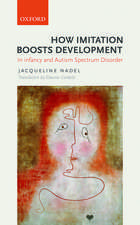Multilevel Dynamics in Developmental Psychopathology: Pathways to the Future: The Minnesota Symposia on Child Psychology, Volume 34: Minnesota Symposia on Child Psychology Series
Editat de Ann S. Mastenen Limba Engleză Paperback – 14 noi 2012
Featuring contributions from leading researchers in developmental psychopathology, this volume presents integrative thinking and research across several levels of analysis and disciplines. The first three chapters highlight the interactions of biology and context in development, reviewing the latest work on genes-environment interplay in development, and how disorders arise from interactions of biological susceptibilities and exposure to pathogenic contexts. The next three chapters focus on social dynamics of children in families and peer groups, and how these social interactions shape and regulate behavior. Resilience processes are discussed, as well as the implications of research on peer dynamics for prevention, school policies, and treatment. Longitudinal research on depression is examined in relation to the interplay of vulnerability, context, stress, and cognition in development. The book concludes with an illustration of the challenges and benefits of encompassing multiple levels of analysis in a single research program.
Ideal for researchers and advanced students in developmental, clinical, and educational psychology, Multilevel Dynamics in Developmental Psychopathology provides a tantalizing preview of the future of this multidisciplinary science and its applications. This book illuminates the roads leading to more cohesive research on positive as well as pathological development, across levels of analysis and disciplines, and its potential for prevention and treatment.
Preț: 328.39 lei
Preț vechi: 419.32 lei
-22% Nou
Puncte Express: 493
Preț estimativ în valută:
62.84€ • 65.24$ • 52.40£
62.84€ • 65.24$ • 52.40£
Carte tipărită la comandă
Livrare economică 22 martie-05 aprilie
Preluare comenzi: 021 569.72.76
Specificații
ISBN-13: 9780415655668
ISBN-10: 0415655668
Pagini: 368
Dimensiuni: 152 x 229 mm
Greutate: 0.68 kg
Ediția:1
Editura: Taylor & Francis
Colecția Psychology Press
Seria Minnesota Symposia on Child Psychology Series
Locul publicării:Oxford, United Kingdom
ISBN-10: 0415655668
Pagini: 368
Dimensiuni: 152 x 229 mm
Greutate: 0.68 kg
Ediția:1
Editura: Taylor & Francis
Colecția Psychology Press
Seria Minnesota Symposia on Child Psychology Series
Locul publicării:Oxford, United Kingdom
Public țintă
ProfessionalCuprins
Contents: Preface. Rutter, Gene-environment Interplay and Developmental Psychopathology. Hanson, Gottesman, Choreographing Genetic, Epigenetic, and Stochastic Steps in the Dances of Developmental Psychopathlogy. Boyce, A Biology of Misfortune: Stress Reactivity, Social Context, and the Ontogeny of Psychopathology in Early Life. Egeland, Understanding Developmental Processes of Resilience and Psychology: Implications for Policy and Practice. Fiese, Spagnola, The Interior Life of the Family: Looking From the Inside Out and the Outside In. Dishion, Piehler, Peer Dynamics in the Development and Change of Child and Adolescent Problem Behavior. Garber, Depression in Youth: A Developmental Psychopathology Perspective. Cicchetti, Valentino, Toward the Application of a Multiple-Levels-of-Analysis Perspective to Research. Sroufe, Commentary: The Place of Development in Developmental Psychopathology.



























